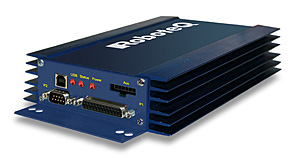Roboteq launches HBL2350, a smart controller which can drive two brushless DC motors each up to 75A and 50V simultaneously. HBL2350 is the first in the category of dual channel, high current brushless motor controllers. It could be used in controlling two-wheel driven tiny electric vehicles, balancing scooters, automatic guided vehicles (AGVs) and other control applications requiring high power brushless motors.
 HBL2350
HBL2350
Commands can be issued to the controller either through a joystick or an analog pedal and it comes with a standard R/C radio for easy robotic applications using remote control via RS232 interface or USB. The controller can be designed using a single port for use with semi-autonomous or fully autonomous robots by connecting it with Wi-Fi adapters, wireless modems or single board computers. The controller is capable of executing more than 50,000 basic instructions in 1s with the help of an in-built basic language interpreter. This capability is extremely useful for adding custom functions through powerful scripts without the need for an external microcomputer or PLC. The two channels of the controller are capable of independent as well as combined operations.
The motors may function in closed or open loop position or speed modes with an update rate of 1 kHz. Optical encoders or motor's hall sensors of the HBL2350 can be used to determine travelled distance and speed with high precision. The smart current sensing feature of the controller narrows down the maximum power output to 75A under all load conditions. There is an in-built stall, overheat and short circuit protection in the controller. The controller can accommodate up to 19 digital, 6 pulse and 11 analog inputs and can provide up to eight 1A digital outputs that can be used for activating brakes, lights, valves and other devices. The controller measures 228 x 140 x 40mm and is housed in a robust aluminium case which acts like a heat sink. The controller can be upgraded for various applications by downloading the required software from Roboteq’s website.